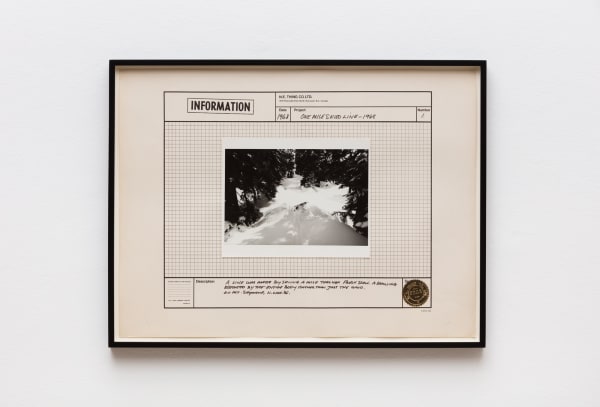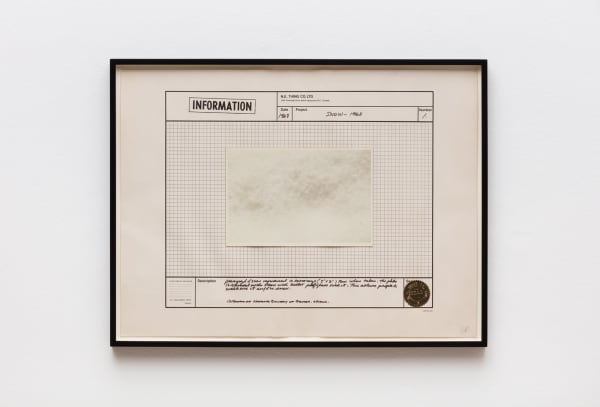IAIN BAXTER&: &Information
The preview will coincide with the opening of Iain Forsyth and Jane Pollard, Multigraphs at Kate MacGarry and Archive Fever at Emalin.
Hales is delighted to announce &Information, IAIN BAXTER&’s first solo exhibition with the gallery. Pioneering conceptual artist BAXTER& sees the world as an Infoscape, viewing ordinary life in an extraordinary way. Centring on photographic works, the exhibition explores the artist’s philosophy of art as information, encompassing technology, ideology and social organisation.
IAIN BAXTER& was born in Middlesbrough, England before moving to Calgary, Canada, a year after he was born. In 2005 Iain Baxter became IAIN BAXTER&, legally changing his name - the ampersand symbolises an unending collaboration with the viewer and the interconnectedness of life. Often referring to himself as The &Man, he has trademarked his name (BAXTER&), the ampersand (&) and cultivated a brand.
Over a rich and complex practice spanning sixty years, BAXTER& ‘has been transforming our terms of engagement with representations of the natural environment to reflect the changing stresses of an information society.’[1] The artist formulated the term Infoscape to express reading the world as a signifier for humanity, through our built societies and methods of communication. In an oeuvre that encompasses installation, painting, performance, collaborations, sculpture and film - photography remains a constant. BAXTER& is never without a camera, a habit ingrained from his time as a Zoology student, learning the rigorous practice of documentation on research trips. Prophetic in his vision of the future of the medium, BAXTER& made the astute observation that photographs primarily act as a “memory device”[2] and a means to understand the world. Predicting the age where photographs equate to validation on social media, BAXTER& coined the phrase ‘landscape worship’ to describe the phenomenon of people feeling obsessively compelled to document the places they visit.
The artist draws from a wide-range of influences, most notably the writings of Marshall McLuhan, whose theories on media have been foundational to the artist’s practice, to the extent that the Canada Council Molson Prize committee stated that BAXTER&’s highly regarded conceptual installations and projects, as well as his photography, earned him the label: “The Marshall McLuhan of the visual arts.” The works in &Information are exemplary of BAXTER&’s ongoing exploration of visual information, in accordance with McLuhanesque theory: ‘Today the whole idea of art is that it is an instrument of discovery and perception.’ (Marshall McLuhan, 1966 [3])
BAXTER& sees himself ‘as an explorer of information’[4]. In this exhibition, the viewer is invited to discover the unique way the artist thinks through the road trips that inform his work. Seen as a coming of age rite of passage, the ‘road trip’ is equated with a sense of discovery linked to North American identity and popular culture. Writers such as Tom Wolfe and Jack Kerouac, and films like Easy Rider, depict the driver as the ultimate American anti-hero, free from the constraints of day to day life. BAXTER& does not glamorise the landscape, instead abandoning the romantic notion of “the great outdoors,” focusing on the mundane elements that puncture the vast expanse of the road as empty billboards and commercial signs become the landmarks.
The two series of Polaroid images - Reflections of America and Images of America - which are a major feature of this exhibition, were taken by BAXTER& on a road trip across 31 states of the US in 1981. Polaroid Corporation supplied the artist with cameras, film and a campervan for his trip as part of their Artist Support Program, an initiative that encouraged contemporary artists (including David Hockney, William Wegman, David Bailey and Helmut Newton) to use Polaroid cameras in their contemporary practice. The immediacy of creating a one of a kind artwork suits BAXTER&’s spontaneity and he still claims that it is the only format that can “keep up with my ideas.”[5] The images in Reflections of America and Images of America document a country with a rapidly changing culture. Art critic and curator Lucy Lippard states ‘through BAXTER&’s eyes, almost everything is surprising, and his gift is communicating this sense of wonder, making us see what we weren’t looking for.’[6] More than just captured moments in time, in these images BAXTER& has physically turned away from traditional attractions, drawing the viewers’ attention to the surrounding areas, consequently providing a provocative image which is out of sync with preconceived expectations of beauty and majesty.
Also featured in &Information are works by the legendary conceptual enterprise N.E. Thing Co., a company BAXTER& formed with Ingrid Baxter in 1968. This was an innovative, collaborative way of making work anonymously under a fully functioning company, using authentic corporate strategies to confuse the art world. The business was expansive; N.E. Thing Co. cultivated scientific research methods, went on an expedition to the Arctic, created an operational office, sponsored a junior hockey team, operated a commercial photography lab and even had a working restaurant, ‘Eye Scream’. The concept for making art under the guise of a corporation was the first of its kind, reaching critical acclaim when N.E. Thing Co., was featured on the front cover of Art in Americain May 1969, had a solo exhibition at the National Gallery of Canada that same year, was included in the Information exhibition at the Museum of Modern Art, New York, in 1970, and mounted a solo exhibition at Sonnabend Gallery, New York, in 1971.
Transcanada highway, near Fort William, Ontario, Canada (1968) is an exceptional example of a rare early work by IAIN BAXTER&, made in collaboration with N.E. Thing Co. Prefiguring Jeff Wall by ten years, the artist pioneered the method of illuminating photographic works on a lightbox. BAXTER&’s inspiration for this new method of presentation came from the prominence of the advertising industry, and from looking at the mesmerizing irradiate transparencies of art history slides in a dark lecture hall at university. Resourcefully, BAXTER& transformed a doctor’s light box for viewing x-rays into a glowing work of art, the format dictated by the medical standardized size of the equipment.
In works brought together by this exhibition, BAXTER& uses the universal experience of looking through a car window to reframe what art is and how we look at everything around us. Exploring the pertinent connection between identity and the urban environment, the work forces the gaze into a permanent tension between the minutiae of everyday life and the backdrop of the wider world: ‘In the end we each live our own landscape inside the Infoscape – Landscape as Lifescape.’[7]
IAIN BAXTER& (b.1936, Middlesbrough, England) and his family moved to Calgary, Canada, a year after he was born. In 1959 he graduated from the University of Idaho with a degree in Zoology, going on to complete a Masters in Education and in Fine Arts from Washington State University in 1964. He currently lives in Windsor, Ontario, with his wife and collaborator Louise Chance Baxter& (collaborations include One Canada video, 1992).
IAIN BAXTER&’s achievements have been recognised by major prizes, among them is the Canada Council for Arts Molson Prize and the Governor General’s Award in Visual and Media Arts. In addition, he was named a Member of the Order of Ontario and of the Order of British Columbia as well as Officer of the Order of Canada. He holds an Honorary Doctorate from University of British Columbia, he was made Professor Emeritus by the University of Windsor and in 2013 he was named a Fellow of the Royal Society of Canada. In 2011 his work was the subject of a retrospective jointly organised by Art Gallery of Ontario (ON, Canada) and Museum of Contemporary Art, Chicago (IL, USA) accompanied by a comprehensive catalogue. BAXTER&’s work has been exhibited widely at institutions including Museum of Contemporary Art, Los Angeles, CA, USA; Jewish Museum, New York, NY, USA; Museum of Modern art, New York, NY, USA; and Kunstmuseum, Basel, Switzerland. International public collections with BAXTER&’s work include National Gallery of Canada, Ottawa, ON, Canada; Art Gallery of Ontario, Toronto, ON, Canada; Museum of Modern Art, New York, NY, USA; Tate Modern, London, UK; Montreal Museum of Fine Arts, Montreal, QC, Canada; Detroit Institute of Art, Detroit, MI, USA; Los Angeles County Museum, Los Angeles, CA, USA; and Gemeentemuseum, The Hague, Holland.
[1] Lauder, A. ‘The ‘Information Landscape’ of Iain Baxter&’ in Continuum – Journal of Media & Cultural Studies, 2015, p913
[2] Silcox, D. Art is All Over, IAIN BAXTER& Photographs 1958-1983 ‘3 Minute Photos’ p22
[3] Cavell, R. McLuhan in Space – A Cultural Geography, University of Toronto: 2002, p185
[4] Bellman, D. quoted IAIN BAXTER& ‘Frameworks for an Intervention’ https://frameworksforanintervention.wordpress.com/author/frameworksforanintervention/ (2012)
[5] Conversation with the artist 20/09/18
[6] Lippard, L. Passing Through, IAIN BAXTER& Photographs 1958-1983 ‘3 Minute Photos’, Art Gallery of Windsor: 2006 p11
[7] Artist Statement in ‘Landscape Works’ catalogue, 1999, p46
















